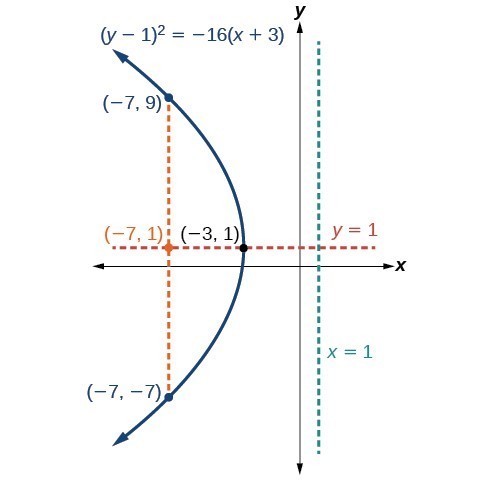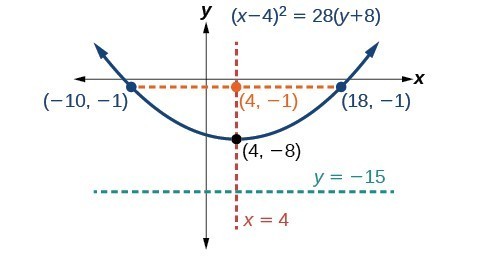Graphing Parabolas with Vertices Not at the Origin
Like other graphs we’ve worked with, the graph of a parabola can be translated. If a parabola is translated units horizontally and units vertically, the vertex will be . This translation results in the standard form of the equation we saw previously with replaced by and replaced by . To graph parabolas with a vertex other than the origin, we use the standard form for parabolas that have an axis of symmetry parallel to the x-axis, and for parabolas that have an axis of symmetry parallel to the y-axis. These standard forms are given below, along with their general graphs and key features.
A General Note: Standard Forms of Parabolas with Vertex (h, k)
The table and Figure 9 summarize the standard features of parabolas with a vertex at a point .| Axis of Symmetry | Equation | Focus | Directrix | Endpoints of Latus Rectum |
 Figure 9. (a) When , the parabola opens right. (b) When , the parabola opens left. (c) When , the parabola opens up. (d) When , the parabola opens down.
Figure 9. (a) When , the parabola opens right. (b) When , the parabola opens left. (c) When , the parabola opens up. (d) When , the parabola opens down.How To: Given a standard form equation for a parabola centered at (h, k), sketch the graph.
- Determine which of the standard forms applies to the given equation: or .
- Use the standard form identified in Step 1 to determine the vertex, axis of symmetry, focus, equation of the directrix, and endpoints of the latus rectum.
- If the equation is in the form , then:
- use the given equation to identify and for the vertex,
- use the value of to determine the axis of symmetry,
- set equal to the coefficient of in the given equation to solve for . If , the parabola opens right. If , the parabola opens left.
- use , and to find the coordinates of the focus,
- use and to find the equation of the directrix,
- use , and to find the endpoints of the latus rectum,
- If the equation is in the form , then:
- use the given equation to identify and for the vertex,
- use the value of to determine the axis of symmetry,
- set equal to the coefficient of in the given equation to solve for . If , the parabola opens up. If , the parabola opens down.
- use , and to find the coordinates of the focus,
- use and to find the equation of the directrix,
- use , and to find the endpoints of the latus rectum,
- If the equation is in the form , then:
- Plot the vertex, axis of symmetry, focus, directrix, and latus rectum, and draw a smooth curve to form the parabola.
Example 5: Graphing a Parabola with Vertex (h, k) and Axis of Symmetry Parallel to the x-axis
Graph . Identify and label the vertex, axis of symmetry, focus, directrix, and endpoints of the latus rectum.Solution
The standard form that applies to the given equation is . Thus, the axis of symmetry is parallel to the x-axis. It follows that:- the vertex is
- the axis of symmetry is
- , so . Since , the parabola opens left.
- the coordinates of the focus are
- the equation of the directrix is
- the endpoints of the latus rectum are , or and
 Figure 10
Figure 10Try It 5
Graph . Identify and label the vertex, axis of symmetry, focus, directrix, and endpoints of the latus rectum. SolutionExample 6: Graphing a Parabola from an Equation Given in General Form
Graph . Identify and label the vertex, axis of symmetry, focus, directrix, and endpoints of the latus rectum.Solution
Start by writing the equation of the parabola in standard form. The standard form that applies to the given equation is . Thus, the axis of symmetry is parallel to the y-axis. To express the equation of the parabola in this form, we begin by isolating the terms that contain the variable in order to complete the square.
It follows that:
- the vertex is
- the axis of symmetry is
- since and so the parabola opens up
- the coordinates of the focus are
- the equation of the directrix is
- the endpoints of the latus rectum are , or and
 Figure 11
Figure 11